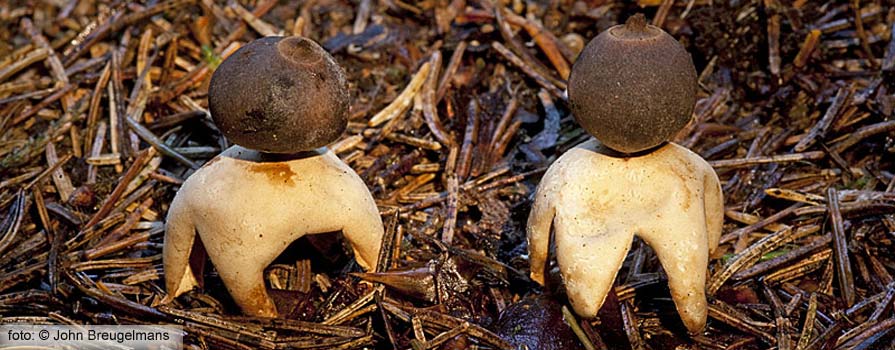
Photo: Rayed Earthstar
Notice !
« habitat: coniferous
« star-rays: number 4(-6), almost vertically spread (=fornicate)
« stem: at older age there is a short stem (under left balloon)
« mouth-zone: fibrillose (fimbriate), with ring-furrow and court
« balloon: darker than star-rays (uncommon)
« nest: the nest of encrusted debris (mycelial cup) excluded.
|
Rayed Earthstar
(Geastrum quadrifidum)
NMV Ga 211100
|
|
Habitat:
Mainly a coniferous earthstar, found in forests with an age of sixty years and older, at calcareous sand and clay.
Outside of the Netherlands also in deciduous woods and on open grassland vegetations at calcareous soil.
Round 1890 a lot of walking sandhills (pleistocene and dunal) in the Netherlands were fixated against the wind
by planting pine trees. Experimental calc was added often to prepare the soil for pine tree growth.
A lot of the older Rayed Earthstar habitats were situated in such planted pine forests. Their number is starting to decrease.
in the last decennia. Cause might be the age of the forest or the decalcification process by acid rain.
After World War II in the Flevopolders a lot of pine forests are planted. These forests are now in their optimum
for Rayed Earthstar.
|
|
Wood species:
Coniferous (abies, juniper, larch, pinus)
Rare in deciduous wood (els, birch, sea buckthorn)
|
|
Regional:
Urban Amsterdam Area: No.
Pleistocene Area: Smithuyzerbos (Gooi).
Northsea Dunal Area: AWD.
|
Mistakability Rayed Earthstar:
- Dwarf Earthstar (Geastrum schmidelii)
Has a plicate-furrowy mouth-zone, a baldy balloon and no fornicate or high convex star-rays
- Tiny Earthstar (Geastrum minimum)
Has a fibrillose (fimbriate( mouth-zone, and no fornicate or high convex star-rays,
and always has encrusted debris.
- Arched Earthstar (Geastrum fornicatum)
Larger model, longer stem, without court, without ring-furrow.
|
|
How to exclude mistakability:
- Notice the star-rays shaped
- Notice the mouth-zone: fibrillose or plicate-furrowy ? Court yes/no ?
- If the court (and mouth-zone) is elevated, compare with Tiny Earthstar
- Turn around the earthstar is it fixed to the ground? (Encrusted debris, nest)?
- If this is not helpful: dry the earthstar,
and see what changes during the dry-process: stem, apophyse, scar, collar, mouth-zone
|
|
Field-marks: See: Anatomy Genus Geastrum
Rayed Earthstar field-marks:
- Species size: small
- Stem (below balloon): stem (short=1-1.5 mm, broad=1-5 mm, often lighter than balloon)
- Apophyse rounded bag-shaped
- Balloon in diameter: 5-15 mm.
- Balloon surface: yound floury (little white cristalline grains)
- Balloon color: young grey
- Balloon color: older light to dark grey to brown
- Balloon mouth-zone: fibrillose, often with ring-furrow, conical, with (often elevated) court
- Star-rays aantal: 4 (rare 3-6)
- Star-rays in diameter 1-4 cm.
- Star-ray-thickness: fresh upto 2 mm dik
- Star-rays-top side color: young white to creme, older brown, sometimes collared
- Star-rays: encrusted debris, "nest-earthstar"(mycelial cup under the star-rays)
- Star-rays: no scar
- Star-rays: young curled down(=saccate) older almost vertically spread (=fornicate of high-convex), non-hygroscopic
- Star-rays: bottom side color first white, later dirty-white
- Mycelial cup: Nest-earthstars growing with a mycelial cup under their star-rays, fly away from the nest later;
The mycelial cup is young bald and white, older it becomes light-brown.
|
Literature:
Chrispijn, R. ed. (1999), Champignons in de Jordaan (De paddenstoelen van Amsterdam), Schuyt en Co, 162-163.
Hansen L. & H. Knudsen (1997), Nordic Macromycetes, Vol. 3, Heterobasidioid, aphyllophoroid and gasteromycetoid basidiomycetes, Kopenhagen, 1997, 444 pp.
Jalink, Leo M (1995) De aardsterren van Nederland en België, Coolia 38 Supplement.
www.mycobank.com
|
Top
|